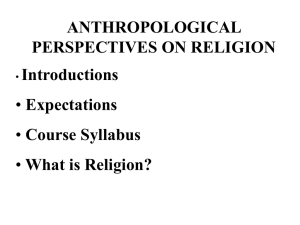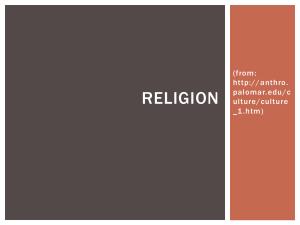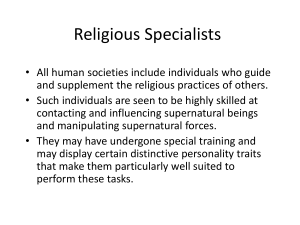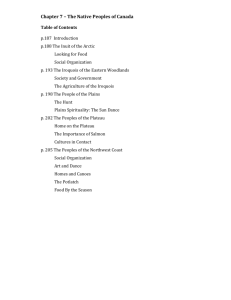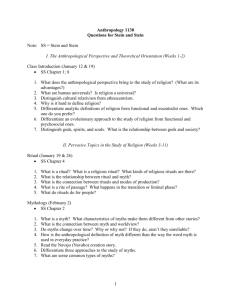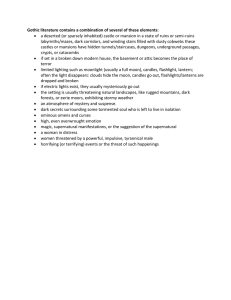Cosmology and Religion Theories of Religion Supernatural Explanations of Misfortune
advertisement
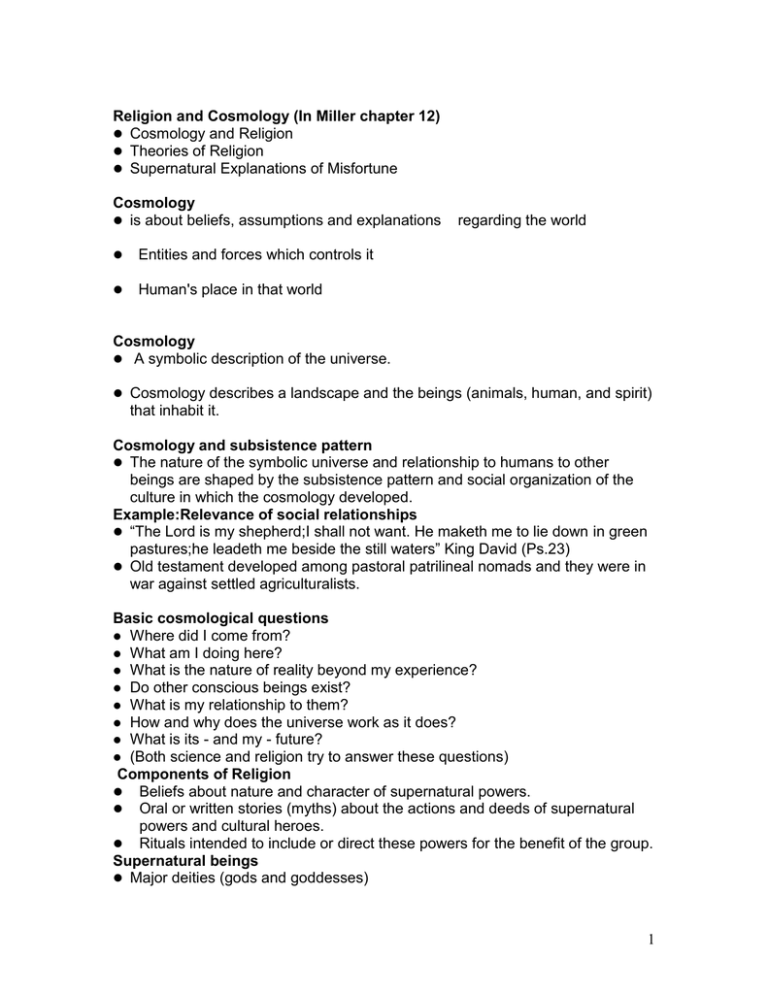
Religion and Cosmology (In Miller chapter 12) Cosmology and Religion Theories of Religion Supernatural Explanations of Misfortune Cosmology is about beliefs, assumptions and explanations Entities and forces which controls it Human's place in that world regarding the world Cosmology A symbolic description of the universe. Cosmology describes a landscape and the beings (animals, human, and spirit) that inhabit it. Cosmology and subsistence pattern The nature of the symbolic universe and relationship to humans to other beings are shaped by the subsistence pattern and social organization of the culture in which the cosmology developed. Example:Relevance of social relationships “The Lord is my shepherd;I shall not want. He maketh me to lie down in green pastures;he leadeth me beside the still waters” King David (Ps.23) Old testament developed among pastoral patrilineal nomads and they were in war against settled agriculturalists. Basic cosmological questions Where did I come from? What am I doing here? What is the nature of reality beyond my experience? Do other conscious beings exist? What is my relationship to them? How and why does the universe work as it does? What is its - and my - future? (Both science and religion try to answer these questions) Components of Religion Beliefs about nature and character of supernatural powers. Oral or written stories (myths) about the actions and deeds of supernatural powers and cultural heroes. Rituals intended to include or direct these powers for the benefit of the group. Supernatural beings Major deities (gods and goddesses) 1 Ancestral spirits Other sorts of spirit beings Religion and the supernatural Supernatural implies that the realm of gods and spirits is outside of or in opposition to the “natural” or physical world (Western bias). Religion and the supernatural In many other societies, the existence and actions of gods and spirits are part of the natural order. Spirits have their place in the physical world just as humans do. What is religion and magic? Religion attempts to please supernatural forces - Frazer Religion serves society by giving it cohesion through shared symbols and rituals Durkheim Religion is a “projective system” that expresses people’s unconscious thoughts, wishes and worries - Freud Religion offers a “model of life” – Geertz Early scholars assumed magic would be replaced by religion, which would be replaced by science Magic/Malinowski “Magic is a practical art consisting of acts which are only means to a definitive end expected to follow later on”. Religion is a body of self-contained acts being themselves the fulfilment of their purpose… Theories of Religion Intellectual (Cognitive) – Humans want explanations for the world around them. Psychological – Religion helps people cope with times of difficulty. Sociological – Religion has a useful effect on human societies. Intellectual (cognitive approach) Without religion , much of the world would be incomprehensible and inexplicable. This is intolerable to the mind of a conscious, reasoning, problem solving species like Homo Sapiens. Sir James Frazer – in Golden Bough argued that thought progressed through 3 stages: magic, religion, and science. Objective knowledge vs religion Religion and objective knowledge/science can complement each other. E.g. Trobrianders work in the garden but there is a garden magic. E.g. There is a sophisticated Trobriander sailing system but there is magic to provide safety (it addresses their psychological safety). 2 Contemporary athletes also use magic to help them concentrate. Religion versus science System of meaning (Symbolic system) Religion: Explanation Magic: Manipulation System of information Science: Explanation Technology: Manipulation/control Psychological approach Religion provides a positive force for self preservation (Malinowski). It addresses the fear of death and the importance of human life. It helps to cope with difficult and dangerous phenomena. Belief in the power of ritual to control the uncontrollable removes anxiety. Earlier explanations Animism Belief in supernatural beings (soul vs. body) (L) anima: soul Animatism Belief in supernatural powers (mana & taboo) Animism A belief in spirit beings, other than ancestors, who are believed to animate all of nature. These spirit beings are closer to humans than gods and goddesses and are concerned with human activities. Animism is typical of peoples who see themselves as a part of nature rather than superior to it. How A Belief in Supernatural Beings Is Perpetuated Through what are interpreted as manifestations of power. Supernatural beings possess attributes familiar to people. Myths serve to rationalize religious beliefs and practices. Supernatural Explanations of Misfortune Belief that common misfortunes are caused by spiritual powers. Belief that misfortunes are caused by the action of some evil human who is using supernatural powers against the affected person. Animatism (Mana and taboo) Mana: belief in an immanent supernatural domain or life force, potentially subject to human manipulation. Melanesian mana is defined as a sacred impersonal force that is much like the Western concept of luck. 3 Magic Based on two kinds of logical principles. imitative principle - the premise that like produces like (voodoo doll). contagious principle - assumption that power comes from contact. Sorcery is an evil form of magic. It can be a use of medicine for evil ends. Anyone can learn it. It is conscious while witchcraft can be unconscious. Sorcerers can use their power to control the spirits to bring harm to others. Views of Witchcraft Azande of southern Sudan - witches possess a substance that leaves their bodies at night and eats the flesh and internal organs of their victims. Functions of witchcraft Effective way for people to explain away personal misfortune without having to shoulder any of the blame themselves. Provides an outlet for feelings of hostility and frustration without disturbing the norms of the larger group. Brings social tension into open. It has a normative effect on society: People may try to avoid being accused of witchcraft. They may also avoid to be exposed to wrath of witchcraft ad avoid offending anybody. Interpretations of Witchcraft and Sorcery Cognitive Explains unfortunate events. Witches serve as scapegoats. Sociological Reinforces cultural norms that help people live harmoniously. Provides an outlet for repressed aggression. Witchcraft can be means of clarifying and affirming social relations. Insider can be labeled as deviant. If the witch is outsider it may function as the reconfirmation of the inside. Sociological approaches (on religion) Religion exists because it is socially useful (Durkheim). Religion promote social solidarity. I.e. It brings people together and enhance their sense of unity, cohesion, and reliance on their society’s customs, shared symbols and rituals. (Miller calls this functional approach, yes it is) Expression of belief (Miller) Myths – Narrative stories about supernatural forces or beings. 4 Doctrine – Direct and formalized statements about religious beliefs, close to “law”. Myths Symbolic stories which define the essential nature of human beings as seen by a particular culture (Miller : “Narrative that has a plot with a beginning, middle and end”). Myths are “true” symbolically since they encode information about values and social relationships. Why myths? “A myth is a charter for society” (Malinowski- Functionalist approach). Myth/Malinowski It is a rationalization of the customs and the behaviours of the group. It is an expression of core beliefs. Myth/Malinowski It teaches morality. Myths should be understood in their present-day social context. Myths/ Claude Lévi-Strauss Myth as a type of thought (Claude Lévi-Strauss-Structuralist approach) Myths/ Claude Lévi-Strauss Illustration of the working out of the universal structural principles which underlie all human cultures. Myths/ Claude Lévi-Strauss Intellectual tool to reflect upon universal and culturally specific oppositions. E.g. Life-death (At a symbolic level to mediate or resolve, e.g. raven example given by Miller p.290) Components of religion (repeat slide) Beliefs about nature and character of supernatural powers. Oral or written stories (myths) about the actions and deeds of supernatural powers and cultural heroes. 5 Rituals intended to include or direct these powers for the benefit of the group. Ritual “Ritual refers to patterned forms of behaviour (Miller p.293). Rituals are formal, invariant acts that require people to join actively in a social collectivity. Religious rituals are prescribed behaviours with reference to beliefs in mystical beings and powers. What is ritual? Classification? Transition from one place to the other? Socially prescribed behaviour in which individuals have little choice? Rituals Rituals convey information about the culture of the participants and, hence, the participants themselves. Rituals are inherently social, and participation in them necessarily implies social commitment. Ritual Life-cycle rituals – separation, transition, reintegration Pilgrimage – e.g. Mecca Rituals of reversal – Halloween Sacrifice Rites of passage (Arnold Van Gennep) “A movement from one cosmic or social world to another”. Passage from – Status – Place – Situation – Time Rite of passage Arnold Van Gennep rites of passage into the following: – Rites of separation – Rites of transition – Rites of incorporation/reintegration Rite of intensification Rituals to mark occasions of crisis in the life of the group. Functions: – Unite people. – Allay fear of the crisis. – Prompt collective action. 6 Religious specialists (Shamans and priests) Priests, (ministers, mullah, rabbi) – Monoteistic – Supreme being – States Shamans – Shamanic – Zoomorphic (plants and animals) – Foraging bands (Anthony F. C. Wallace's Typology of Religions ) Shamans Religious specialists who gain their status through direct relationship with the supernaturals” A part-time specialists. Associated with pre-state societies. Healers can be seen in this category Shamans Skilled at contacting and manipulating supernatural beings and powers through altered states of consciousness. (Going into trance) Provides a focal point of attention for society and can help maintain social control. Benefits for the shaman are prestige, wealth, and an outlet for artistic selfexpression. General religion (for the interested) http://www.uwgb.edu/sar/links.htm http://www.academicinfo.net/religindex.html http://www.wlu.ca/%7Ewwwrandc/internet_links.html http://religion.rutgers.edu/vri/index.html Buddhsim/Islam http://www.infinite.org/bodhiline/wheel132.jpe http://www.wsu.edu/~dee/BUDDHISM/DHAMMA.HTM#DHAMTXT http://www.unn.ac.uk/societies/islamic/ Buddhism Founding figure Siddhartha Gautama Started in India No accepted single text Followers honour Gautama’s teachings Goal is to reach “nirvana” Strong tradition of monasticism Common Features in African Religions Myths about a split between “god” and humans A pantheon of supernatural spirits 7 Elaborate rituals Altars with shrines Close links between healing and divination Directions of Change Revitalization movements – seek to reconstruct parts of religion threatened by outside forces Contested sacred sites – Jerusalem Religious freedom as a human right – Tibetan Buddhist refugees 8

